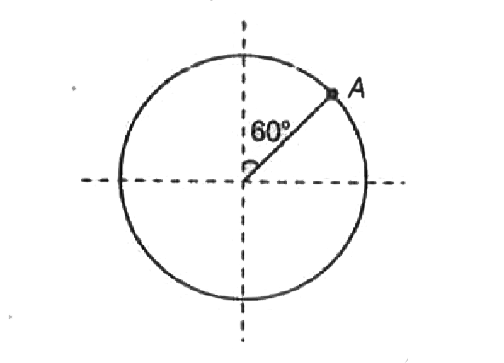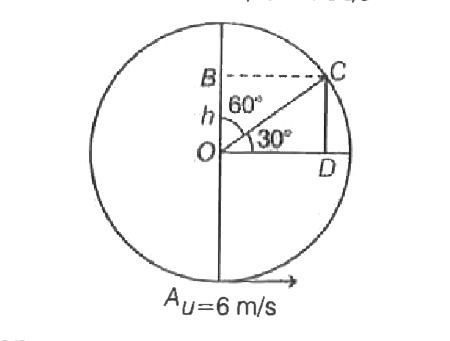A light rigid wire of length 1 m is attached to a ball A of mass 500 g to one end. The other end of the wire is fixed, so that the wire can rotate freely in the vertical plane about its fixed and At the lowest point of the circular motion, the ball is given a horizontal velocity 6 m/s. Determined the radial component of the acceleration of the ball, when this rigid wire makes an angle 60∘ with the upward vertical (Take g=10m/s2)

10m/s2
6m/s2
18m/s2
25m/s2
The correct Answer is:B
Given,
length of a rigid wire, l = 1 m
mass of the ball, m = 500 g = 0.5kg
velocity of ball at a point, C = v m/s

Motion of body in vertical plane is shown in the figure.
InΔBOC
cos602=OBOC
12=h1
⇒h=12m
∴AB=OA+OB=l+h=1+12
AB=32m ....(i)
According to the laws of conservation of energy, (KE+PE) at a point A = (KE + PE) at point C
12mu2+0+12mv2+mg(AB)
u2=v2+2g.32
62=v2+2×10×32
v2=6
∴ Radial component of acceleration of the ball
aC=v2l=61=6m/s2
Related Playlists
Similar Questions
A particle of mass m is attached to an end of a light rigid rod of length a. The other end of the rod is fixed, so that the rod can rotate freely in vertical plane about its fixed end. The mass m is given a horizontal velocity u at the lowest point. (a) Prove that when the radius to the mass makes an angle θ with the upward vertical the horizontal component of the acceleration of the mass (measured in direction of u) is [g(2+3cosθ)−u2/a]sinθ (b) If 4ag ltu2 lt5ag, show that there are four points at which horizontal component of acceleration is zero. locate the points.
View SolutionA sphere of mass m attached with the free end of a steel wire of length l swings in the veritical plane form the horizontal positon.

Elongation of the wire in the vericle positon isView SolutionA particle of mass m is fixed to one end of a light rigid rod of length l and rotated in a vertical circular path about its other end. The minimum speed of the particle at its highest point must be
View SolutionA particle of mass m is fixed to one end of a light rigid rod of length l and rotated in a vertical ciorcular path about its other end. The minimum speed of the particle at its highest point must be
View SolutionA light rigid rod has a small ball of mass m attached to its one end. The other end is hinged on a table and the rod can rotate freely in vertical plane. The rod is released from vertical position and while falling the ball at its end strikes a hemisphere of mass m lying freely on the table. The collision between the ball and the hemisphere is elastic. The radius of hemisphere and length of the rod are R and 2R respectively. Find the velocity of the hemisphere after collision.
 View Solution
View SolutionA particle of mass m is fixed to me one end of a light right rod of length l and rotated in a vertical circular path about its other end. The minmum speed of the particle at its highest point must be
View SolutionA body of mass M is attached to the lower end of a metal wire, whose upper end is fixed . The elongation of the wire is l.
View SolutionA body of mass M is attached to the lower end of a metal wire, whose upper end is fixed . The elongation of the wire is l.
View SolutionA particle of mass m is attached to one end of a light inextensible string and the other end of the string is fixed in vertical plane as shown. Particle is given a horizontal velocity u=√52gl

The tension in the string at an instant when acceleration of the particle is horizontal and √3g isView SolutionA bob is attached to a string of length l whose other end is fixed and is given horizontal velocity at the lowest point of the circle so that the bob moves in a vertical plane. Match the velocity given at the lowest point of circle in column I with tension and velocity at the highest point of the circle corresponding to velocity of column I of column II
 View Solution
View Solution

